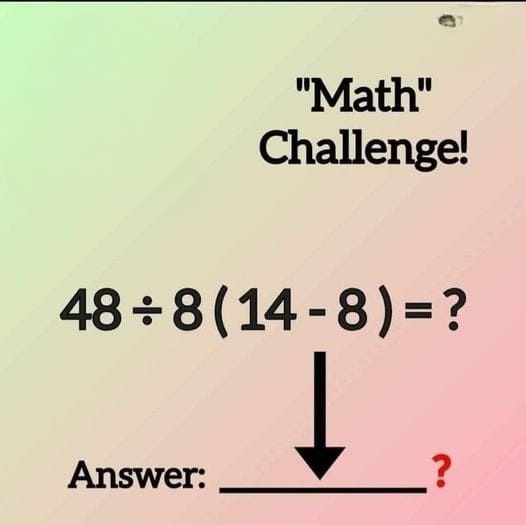
Math puzzles often seem straightforward but can trip up even the most seasoned problem-solvers. One such problem has been circulating online, challenging individuals to apply the correct order of operations. Let’s delve into this intriguing equation and explore the common pitfalls that lead to incorrect answers.
The Puzzle at Hand
Consider the following equation:
48 ÷ 8(14 − 8)
At first glance, it appears simple. However, the way you interpret and solve it can lead to different results.
Common Mistakes
Many people stumble on this problem due to:
-
Ignoring the Order of Operations (PEMDAS/BODMAS): Some calculate from left to right without following the correct sequence of operations.
-
Misinterpreting Implied Multiplication: In expressions like 8(6), the multiplication is implicit, which can lead to incorrect grouping of operations if not handled properly.
-
Misplacing Division and Multiplication Priority: Some assume that division should always come before multiplication, but division and multiplication are at the same level in the order of operations.
Step-by-Step Solution
Let’s solve the equation correctly:
Step 1: Solve Inside the Parentheses
According to PEMDAS, we must handle the parentheses first:
14 − 8 = 6
Now, the equation simplifies to:
48 ÷ 8(6)
Step 2: Understand the Implied Multiplication
The expression 8(6) means 8 × 6. Some might mistakenly think that multiplication should be done before division, but according to PEMDAS/BODMAS, multiplication and division are performed from left to right.
So, the equation now looks like:
48 ÷ 8 × 6
Step 3: Perform Division and Multiplication from Left to Right
Now, we solve the operations in the correct sequence:
-
48 ÷ 8 = 6
-
6 × 6 = 36
However, some argue that the original expression should be interpreted as:
48 ÷ [8 × (14 − 8)]
Following this interpretation:
-
14 − 8 = 6
-
8 × 6 = 48
-
48 ÷ 48 = 1
This discrepancy highlights the importance of clear notation in mathematical expressions.
Final Thoughts
This puzzle serves as a reminder of the critical role that the order of operations plays in mathematics. Whether you arrived at 36 or 1, the key takeaway is the necessity of careful interpretation and adherence to mathematical conventions. Such challenges not only test our computational skills but also our attention to detail and analytical thinking.
So, did you solve it correctly? Regardless of your answer, engaging with these puzzles sharpens your mind and reinforces fundamental mathematical principles.





